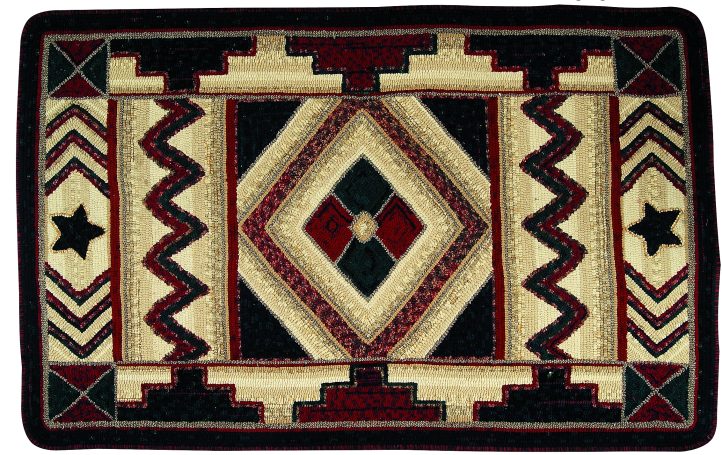
BORDER TO BORDER, 45″ x 30″, #7 and 8-cut wool on linen. Designed and hooked by Cynthia Norwood, Kirtland, Ohio, 1997. This geometric uses straight line directional style hooking. Note that this rug makes use of horizontal, vertical, and diagonal straight line hooking. The larger areas were made less boring by using similar textured fabrics. All fabrics were as-is and recycled. PHOTOGRAPH BY BILL BISHOP/IMPACT XPOZURES
The background of a rug is simply the space between the border and the central motif or design. Sounds so simple. Right? So, try an experiment to prove it. Ask your rug hooking group when they start to think about their rug’s background and color choice and when do they decide how to hook it. You will probably get as many different answers as there are rug hookers in your group.
I have found that teachers, too, will not give a unified answer. Some will say to pick the background color first or they may ask where you plan to use the rug. Others will suggest not picking a specific color, but rather decide on a light or dark background. Some will say to hook the design first then decide on what will work best. And then there’s the group that I belong to—we believe that you can listen to your rug and let it tell you which background is perfect.
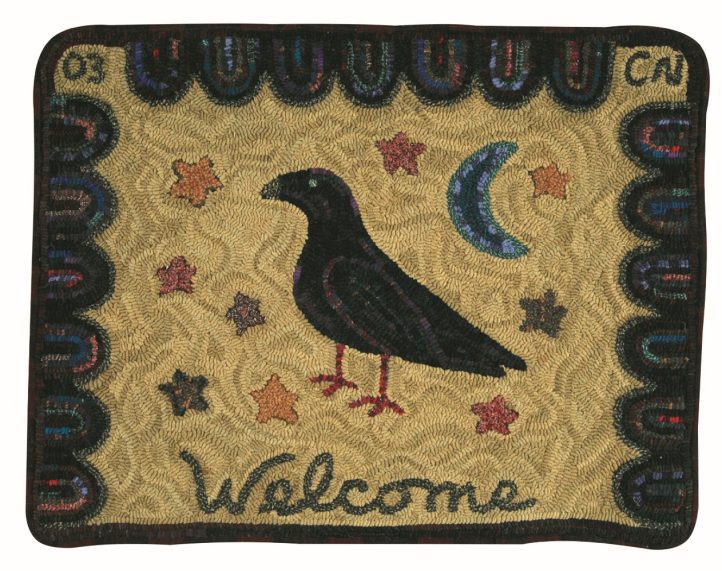
NIGHT CROW, 27″ x 21″, #8 and
9-cut wool on linen. Designed by House of Price. Hooked by Cynthia Norwood, Kirtland, Ohio, 2003. Border of original rug was changed in order to use the hit-and-miss lamb’s tongue.
I never had a conscious thought about my background decisions until my students started asking me questions when they looked at my completed rugs. Such as “Why did you decide? How did you know? Why did you use?” I would get their input on what they thought about their backgrounds and ask the same questions other teachers would. But I always just knew what I would started asking me questions when they looked at my completed rugs. Such as “Why did you decide? How did you know? Why did you use?” I would get their input on what they thought about their backgrounds and ask the same questions other teachers would. But I always just knew what I would do if it were mine. Now, I could tell you that I was just a natural, but I think I was just lucky enough to have excellent art training and color theorists in my youth, and that basic training was augmented later by excellent rug hooking teachers.
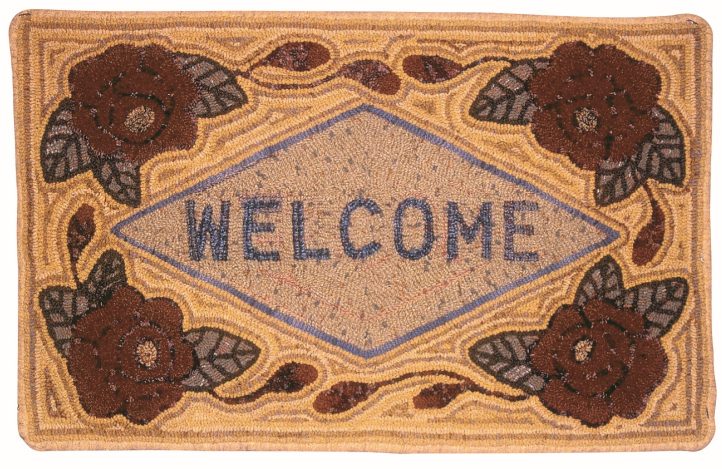
ROSE WELCOME, 30″ x 20″, #8 and 9-cut wool on monk’s cloth.Designed by Laurice Heath of Fredericksburg Rugs. Hooked by P. D. Hankamer, Hankamer, Texas, 2002. This rug shows good use of a medium background using echoing on the outside border. The married fabrics create wonderful movement in this simple design.
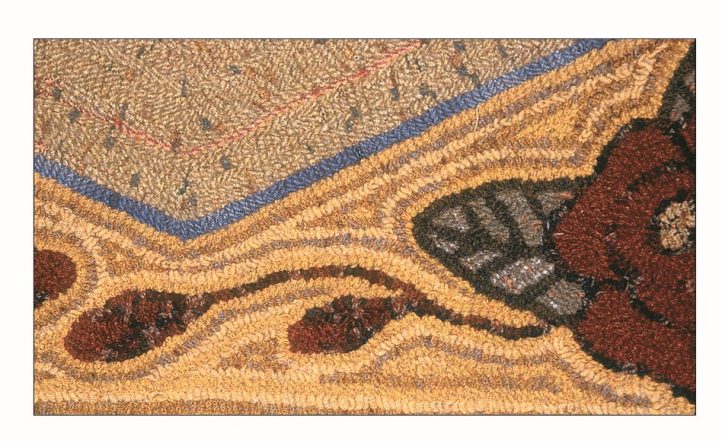
Close up of echoing hooking style on ROSE WELCOME
I like to listen to the rug—let it grow, evolve, and develop gradually. I will place it someplace in the house where I see it several times a day. Then I start picking out a few colors I know I want to use. By the time I start hooking, I just “know” not only what color and value the background will be, but also how I will hook it. Granted this won’t work for everyone, so here are a few things to think about when hooking a background. Of course, you can always give my method a chance.
BACKGROUND
Can make or break a rug.
Should support and enhance the design.
Can cause design to fade, sink etc.
Should not overpower the design.
Can make the design “pop.”
Should receive as much thought as the border and main design.
Can make a rug more interesting.
Can make a rug too busy.
Should not be an afterthought.
Touches your entire rug—the border as well as the design.
Factors to Consider when Hooking Background
Take a few minutes to study your rug and then ask yourself the following questions:
- Is it an Oriental, geometric, tapestry floral, pictorial, single subject or primitive? Choose one category in which it fits best.
- Is it mainly background and borders or is there only a small amount of background?
- Do you want a light, airy rug or a dramatic rug?
- Do you want movement in the background?
- Do you want the pattern to dominate with a quiet background?
- Is your design composed of predominately straight lines or curves?
- If you are visualizing movement in the background, do you see a lot of movement or only a little?
Suggestions
Once you answer these questions, you are on your way to a great background. Orientals and geometrics work best with straight line hooking. Florals, primitives, and animals best tolerate “S” shapes style and echoing. Some primitives also look great with halos or striated as well as hit-or-miss. A complicated design with a small amount of background needs to be calmer than a simple design with a lot of empty background space. If a small background area is too busy either by hooking style or choice of fabrics, the rug will suffer because the design will lose its importance. With a larger area of background, you have more options in hooking style as well as use of more textured and mottled fabrics without losing the rug or design. If you want a light or airy rug, pick a light background color. If you want a more dramatic rug, pick a dark color for the background. For minimal movement in your background either use mottled fabric, several values of the same color, married fabrics, or mix in similarly colored textured fabrics. For a very calm background, use lightly mottled fabrics or closely related values. If you are more adventuresome and your rug will accept a busier background, use an assortment of textures, tweeds, colors and even hooking styles. This will make hooking the background much more fun to hook, but don’t get so carried away that you let the background overwhelm your design or motif. I suggest never using solid, commercially dyed wool for your background. It can make the rug look lifeless or dead. It takes very little time or talent to mottle the fabric.
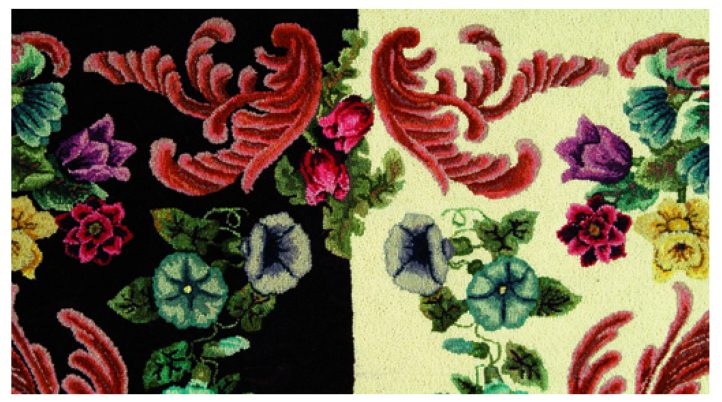
UNTITLED, 35″ x 18″, #3-cut wool on burlap. Designer unknown. Hooked by Cynthia Norwood, Kirtland, Ohio, 1980. Author’s teaching piece. One half of this pattern was hooked with Dorr natural spotted with old ivory. The other half was hooked with eggplant spotted with orange dye. Cover each half individually. Compare each. Usually one side will appeal to you more than the other.
For the novice or beginning rug hooker, I would suggest that the easiest thing to do when thinking about the background is to first decide the value of the background. Do you want a light and airy rug or a heavier, more dramatic rug? At first do not even think of the specific color—just think light or dark (not medium). If you remember the value of the chosen background, you can hook the entire motif first.
If you want to make it even easier when beginning a new project, pick the color also. You may not have access to as many colors and values of wool as more experienced rug hookers do. So making decisions early on will make it an easier and perhaps less expensive project. Hooking some of the background immediately around the design will let the novice know whether the fabric will work or not.
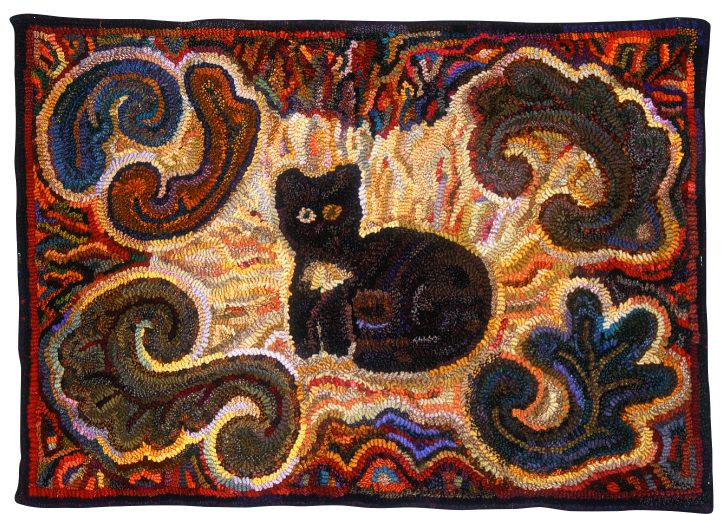
SARSAPARILLA, 31″ x 22″, hand-cut strips of wool on cotton. Designed and hooked by Jule Marie Smith, Ballston Spa, New York, 2002. Note all the movement in not only the background, but also in the outside border. Jule Marie calls this “higglety pigglety” hooking. It also can be considered striated. There also is minor echoing done around the scrolls. The use of the many various colors does not detract but adds more interest to this rug. Imagine how it would look with a plain, simple background.
THINGS TO THINK ABOUT
Look at photos of rugs from various dates. Compare the backgrounds. You will see changes throughout the decades.
If the background is too busy whether in color, texture or hooking style, it can detract from the beauty of the rug. It can quickly become the rug you never finish or hide in the closet.
In a rug with a simple design, tweeds, textures and mottled colors are much more successfully used. Don’t consciously try to balance each of the fabrics or colors—use them randomly.
The wrong background value for your design detracts your eye and brain from a rug; while the perfect one increases the design’s beauty. The wrong background can destroy a beautiful central motif.
With a complicated design and little background area you generally need to keep the background simple and in the background.
Medium value backgrounds are the hardest to use.
A solid background of one value makes a rug look lifeless or “dead.” Mottled fabrics will give it movement or life without making it too busy.
Of all colors, gray is the hardest to work with. If you choose it, do yourself a favor and give it a wash with one of the warm colors you are using in the main design.
A simple design can easily carry a complicated background with many colors, textures and hooking styles.
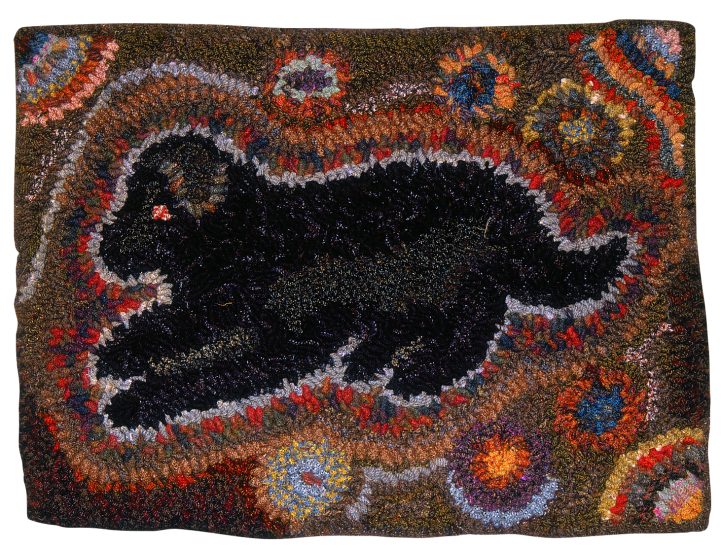
MAGDALENA’S DOG, 21″ x 16″, #10-cut wool on monk’s cloth. Designed and hooked by Barbara Carroll, Ligonier, Pennsylvania, 2003. Note the use of the halo around the dog. The halo echoing style rolls into the round areas that are filled with soft colors. As with many primitives, some of the circles simply fade away.
Deciding Between Light and Dark Backgrounds
The more contrast there is between the edge of the design and the background, the more your eye will be drawn to it and conversely your eye will glide over areas with minimum contrast. Rugs with light backgrounds will need stronger accent colors. Dark backgrounds will work well with pastel tones. Neutral light backgrounds (ecru, tans, beige’s, and off-whites) and very dark backgrounds (maroon, navy blue, antique black, and mahogany) are both easy to use if you simply remember a few things.
If using light background, you need to use medium or darker values on the edges of the design or motif. If the lighter values are used on a lighter background, the design can be lost, disappear, sink, or fade into the background. Conversely, if a darker background is used you must resist using dark values near the edges of the design. Your light and medium values will work well on a dark background. Dark values on a dark background will make a weak rug, edges will be lost, and the design or motif will fade. The more contrast will make a more exciting rug.
Most people find a dark background easiest to work with. The darker background has a tendency to make the design “pop” or come toward you and can create a much more dramatic rug. Also, with dark backgrounds, the height of the loops is not easily noticed. On a light background, the irregular height of loops that most beginners make will be more easily seen. But, one disadvantage to using dark background is that pet hairs are very noticeable.
Medium Value Backgrounds
Medium value backgrounds are the hardest and trickiest to work with, as the design can get lost. You can keep this from happening simply by using light values or dark values (or both light and dark values) on the edges of the design, but no medium values. To be sure that your medium value background will work, it is best to start by hooking at least one row around the edges of the design. It is easier to make changes early on, rather than to hook the entire design and then discover the medium value does not work. Reverse hooking (taking out loops) is not something most of us enjoy.
Medium value backgrounds look better in primitive rugs in which we do not want a distinct contrast, but not in fine, tapestry, or geometric hooking. If medium values are used perfectly they can also make a very soft, subtle rug. But medium-value backgrounds are not to be taken lightly and are best left alone by the novice or beginning rug hooker.
If you find that you are losing the design or it is melting into the background, all is not lost. However, do not outline with normal width of wool and do not use black or a very dark color. Instead cut an extra narrow strip and shadow hook (sometimes known as “hooking in the ditch.”) You will only hook a few loops—sneaking them in between the background and the design. Pull them much lower than the other loops creating an illusion of an outline. Sometimes it is necessary to hook around an entire petal and sometimes just a few loops are adequate. If you use a normal width strip and a very dark color, it will look like you used a Sharpie to outline the design. Remember what your first grade coloring book looked like—that is not the effect most of us want in a hooked rug.
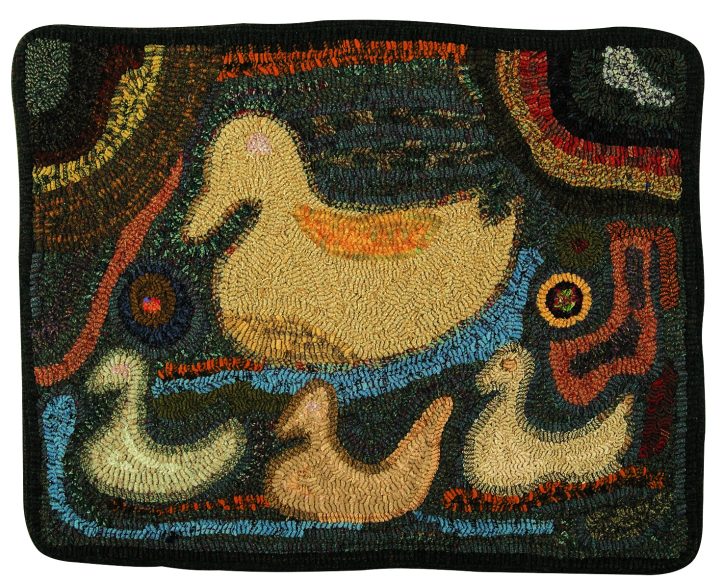
OLDE DUCKS, 25″ x 19″, #10-cut wool on linen. Designed by Magdalena Briner in 1885. Hooked by Barbara Daniels, Sugar Land, Texas, 2004. Barbara used all as-is fabrics in this wonderful sample of a fun background. Because the design is so simple, the background can support much movement not only in textures and hooking styles but also in various colors.
Different Styles of Hooking Backgrounds
Hit or Miss
Hit or miss is usually done in straight lines, but also can be gentle curves and works great in lamb’s tongues or clamshells. Colors and values already used in the rug should be repeated. Do not add many extra colors, but do be careful of placement of colors that have high chroma (brightness). Use those sparingly and in short pieces. Two bright or high chroma colors used close together create too much action for your brain. Always use plenty of neutrals and subdued colors and values for best results. Hit or miss works well in many designs, but especially well with primitives and geometrics.
Shadow Hooking
Shadow hooking is used especially around fine shaded florals. You need to hook a slightly darker fabric than your background choice in one, two, or three rows irregularly around the design. I prefer that the shadow not be the exact outline of the pattern because it can appear simply as a wide outline rather than shadow. Shadow hooking can also be used in primitives, but it usually looks less refined.
Striated Hooking
Striated means narrow lines of hooking usually parallel to each other. Different fabrics are used and the strips start and stop at different spots or lengths. This hooking style is frequently used in pictorials, florals, and also in primitives with wider strips of fabric.
Straight Line Directional
Straight line hooking is much more structured, controlled, and predictable than other hooking styles. It works very well with two specific designs—geometrics and Oriental patterns. The Oriental design can be hooked normally and you can hook one row of background around it or not. I choose not to hook a row around the design as I find it distracting. I would rather hook the background in straight rows from the edge of the exterior border right up to the edge of the design/motif. The Oriental rug can be hooked entirely in straight lines or just the background. Frequently only part of a geometric rug is hooked in straight lines. It is necessary to look at the pattern and see if the entire piece should be done in straight line hooking. Many people find this boring, while others find it very peaceful and fast. You can make it less boring by using mottled fabric or even closely related married fabrics.
“S” Shapes
The “S” shape hooking style is exactly as it sounds. You actually hook “S” shapes randomly and in different sizes in the background area. It is okay to take a permanent Sharpie pen and draw the shapes in various places on the rug. Hook one “S” then hook a row on each side of it. Move on to another “S” and do the same. Gradually you will fill in the remaining space between the “S”s’. The shapes may be drawn in different directions and different sizes, but be careful not to make them too small. The “S” shapes are also known by some as rivers, or hill and dale. This style works well with tapestry or fine shaded pieces as well as primitive patterns. These wavy “S” shapes tend to add an air of playfulness and softness to the rug.

YELLOW BOWL, 44″ x 14″, hand-cut strips of wool on cotton. Designed and hooked by Jule Marie Smith, Ballston, New York, 2004. This wonderful rug has three backgrounds. A primitive type of shadowing helps the design stand alone; a halo is created with several rows of almost 40 different greens, tans, bronzes, and pinks—but all the same value; and the outer most section of “higglety pigglety”, or striated, continues the movement of this rug.
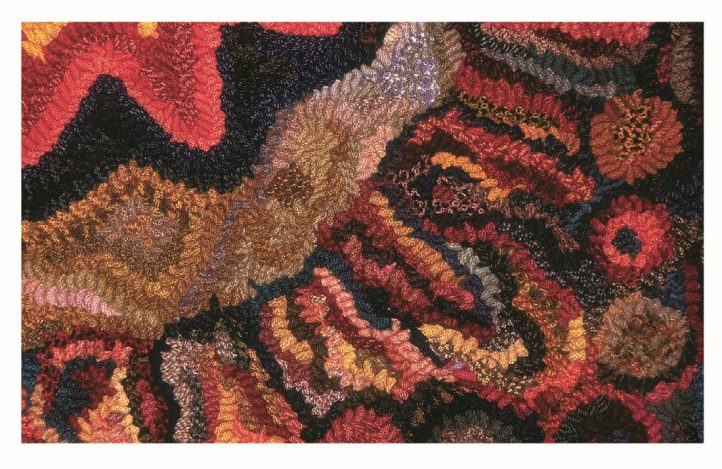
Close up of YELLOW BOWL
Echoing
The term “echoing” is very familiar to those who quilt or collect quilts. One simply hooks a row of background around the design or motif then hooks another row and another—continually following or echoing the central design. Eventually there will be small, irregular spaces that need to be hooked. If there are several motifs in the rug, outline each motif separately several times, and then fill in the spaces between them. Echoing is also conducive to the use of mottled or married fabrics and textures and works well with both primitive and tapestry or fine rug hooking.
Halo Effect
Here you will hook from one to several rows much lighter than the rest of your background. Thus you create a halo effect around the motif. Primitives make the most effective use of this technique.
Spider Hooking
This style is more effective and easier to use with narrow cuts. Simply hook a round area that signifies the body of a spider. Next, hook outward from the body eight squiggly “legs.” Skip over a few inches and hook another spider body and legs. After you have done several spiders, hook around their legs and then fill in the rest of the small areas. This makes hooking a rug with large background areas much less boring, and if using mottled fabric it also gives the background some movement.
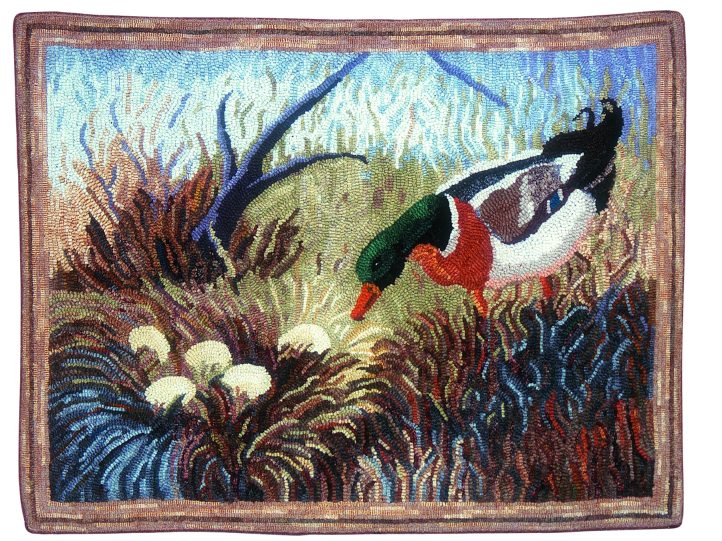
MALLARD DUCK, 26″ x 20″, #4-cut wool on linen. Designed and hooked by Karen Mad-dox, Kerrville, Texas, 2000. Note the perfect use of striated style hooking starting with the nest and moving through the grass to the sky. When looking at this rug, your eyes want to travel and follow the striations.
Make the Background Your Canvas
Any design, but especially primitives, can open a new world to you when considering what to do with the background. Take a few minutes and look at antique rugs. Study rugs you like and figure out what appeals to you. Because many primitive motifs and designs are simple and uncomplicated, it makes it much easier to create a more complicated and exciting background by using not only textures and various hooking styles but also by using many colors. Using an assortment of textures, tweeds, and even different colors makes hooking the background so much more interesting and fun. But don’t get so carried away that you let it overwhelm your motif or design and lose the rug. If the design becomes a minor actor, tone down your background.
After hooking your design, hook one row of background around the design and at least one row next to the outer border or edge of the rug. The rest of the background area is your canvas. You can decide what to do with it so take some time and think about it. Remember, no matter what kind of rugs you hook, make them your own. Look and study other rugs, but do what feels right to you. Take time to play with your rug and it will talk to you. Most importantly, remember there is no one right way to hook the background. Strive to create your own style and be happy with it.
